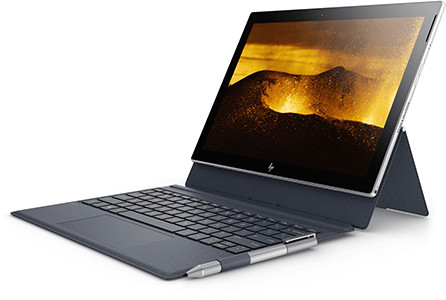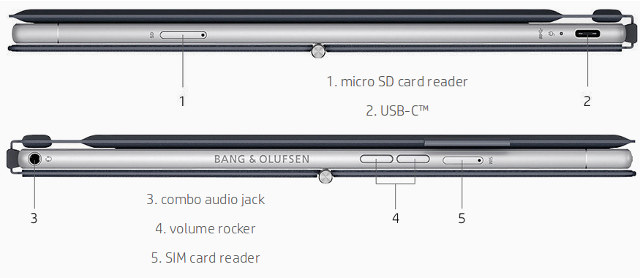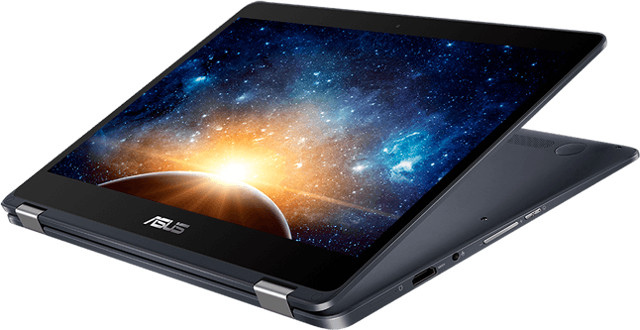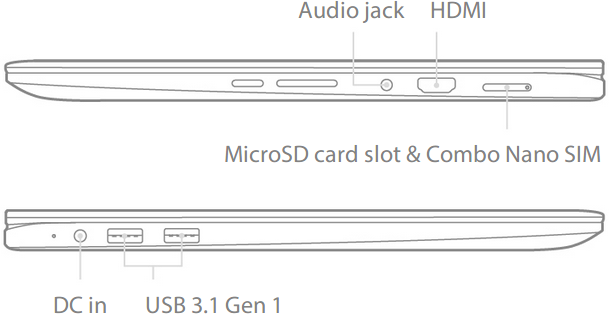Qualcomm and Microsoft showcased some Snapdragon 835 based Windows 10 “Mobile PCs” at Computex 2017 last June, and while the press was allowed film the demo, the device could only be operated by a Qualcomm employee.
But both companies and their partners have made progress, and at the Snapdragon Technology Summit, Qualcomm announced “Always Connected PCs” which will run Windows 10, be always on and always connected at Gigabit LTE speeds, and support all-day battery life while keeping thin and fanless designs. all while incorporating Windows 10. HP and ASUS unveiled their very own “Always Connected PCs”, respectively Envy X2 and Novago TP370. What I used to call laptop or in this case 2-in-1 hybrid (laptop) is now apparently called “Always Connected PC”, but in any case let’s have a closer look at both devices.
HP Envy x2 (2017)
Specifications:
- SoC – Qualcomm Snapdragon 835 Mobile Processor @ 2.6GHz with Adreno 540 GPU @ 710MHz
- System memory – Up to 8GB RAM
- Storage – Up to 256GB UFS 2.0 storage, micro SD card reader
- Display – 12.3″ WUXGA+ (1920 x 1280) touch display
- Audio – 1x combo audio jack; dual speaker; microphone array with Cortana voice-recognition support
- Backlit Keyboard and touchpad
- Connectivity
- WiFi – 802.11a/b/g/n, 802.11ac
- Qualcomm Snapdragon X16 modem (Gigabit LTE with DL: 1Gbps, UL: 150Mbps; 4×4 MIMO); 1x SIM card reader
- Camera – 13MP rear camera and 5MP front camera
- USB – 1x USB-C port
- Misc – Volume buttons
- Battery – Good for up to 20 hours of local video playback, over 700 hours of connected standby
- Dimensions – 6.9 mm thick
- Weight – 1.21 kg
The device will run Windows 10 S, but with option to upgrade to Windows 10 Pro (fee may apply). HP Digital Pen will also be included. The product page has some more information, including a “buy” button to get notified of the launch. Does it really last one full day? According to Qualcomm yes, as the company explains how you could spend a full day using the device on a charge.
ASUS Novago TP370
NovaGo-TP370QL specifications:
- SoC – Qualcomm Snapdragon 835 Mobile Processor @ 2.6GHz with Adreno 540 GPU @ 710MHz
- System memory – 4GB / 6GB / 8GB 1866MHz LPDDR4x (soldered)
- Storage – 64GB / 128GB / 256GB UFS 2.0 storage, micro SD card slot up to 256 GB
- Display – 13.3” LED-backlit Full HD (1920x 1080) display
- Video Output – HDMI
- Audio – 1x audio jack; dual speaker; smart amplifier; microphone array with Cortana voice-recognition support
- Backlit keyboard and PTP touchpad
- Connectivity
- WiFi – 802.11a/b/g/n, 802.11ac (2×2 MIMO)
- Qualcomm Snapdragon X16 modem (Gigabit LTE with DL: 1Gbps, UL: 150Mbps; 4×4 MIMO); 1x Combo Nano SIM (tray with needle)
- Camera – 1280×720 HD camera
- USB – 2x USB 3.1 Gen 1 Type-A ports
- Sensors – Fingerprint sensor
- Battery – 52 Wh lithium-polymer battery good for up to 22 hours battery life, over 30 days of modern standby
- Dimensions – 31.6 x 22.1 x 1.49 cm
- Weight – 1.39 kg
The 2-in-1 laptop always connected PC will run Windows 10 S by default, but a recommended free upgrade to Windows 10 Pro will be offered. More details may be found on the product page. Windows 10 S only allows the installation of apps in Windows Store, and Microsoft own Edge browser (no Firefox, no Chrome), so most people will likely upgrade to Windows 10 Pro, especially if it is free, and this is probably a condition imposed by Microsoft.
ASUS NovaGo is expected to be available early next year, while the HP Envy x2 is planned for Spring 2018. I could not find pricing on the official page, but Liliputing reports an “entry-level model with 4GB of RAM and 64GB of storage should sell for about $599, while an 8GB/256GB model will run $799”.
You’ll find various hands-on video for the Envy x2 (2017) model online, including the one from Engadget embedded below.

Jean-Luc started CNX Software in 2010 as a part-time endeavor, before quitting his job as a software engineering manager, and starting to write daily news, and reviews full time later in 2011.
Support CNX Software! Donate via cryptocurrencies, become a Patron on Patreon, or purchase goods on Amazon or Aliexpress








